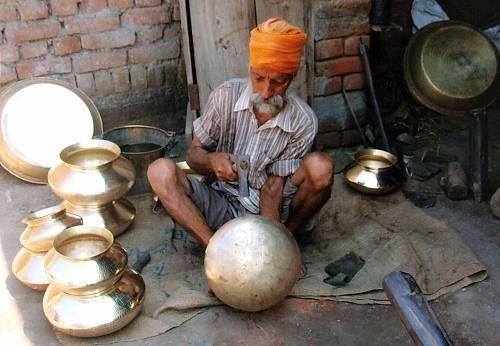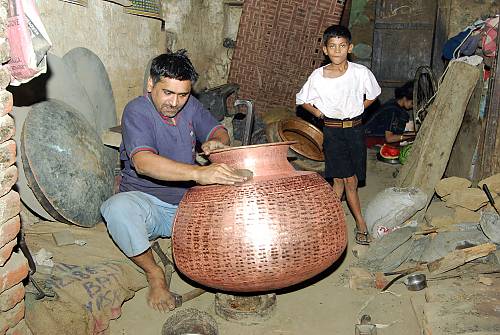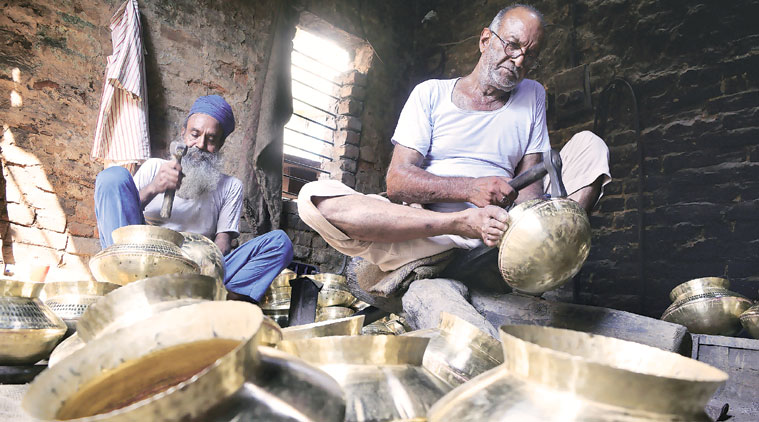Thathera
Contents[hide] |
Thathera community
This is a collection of articles archived for the excellence of their content. |
(From People of India/ National Series Volume VIII. Readers who wish to share additional information/ photographs may please send them as messages to the Facebook community, Indpaedia.com. All information used will be gratefully acknowledged in your name.)
Synonyms: Tamrkar, Thatheri [Bihar and/or Jharkhand] Kasera, Rasera, Tambera, Tambrakar [Uttar Pradesh] Awadhiya (in Mirzapur), Azamgarh, Bangariya, Barhariya, Barwar, Basti, Bhariya (in Lucknow), Bhusauliya, Damdiya Kheriya, Daudiya, Gonda districts, Gorakhpur, Gulraha, Gurha, Jarseth Lodh, Tusaka in Allahabad, Unao [W. Crooke] Surnames: Gupta, Prasad, Ram, Sah, Sao, Singh, Sinha, Thathera [Bihar and/or Jharkhand] Gotra: Kashyap [Bihar and/or Jharkhand]
Utensil making art, Punjab
The art, in brief
Soumyadeep Roy, Preserving India's living heritage for the future,Feb 23, 2016: Deccan Chronicle


India's intangible cultural heritage gets UNESCO accredition
India is a treasure trove of culture and heritage. For centuries India has attracted people from all parts of the world and has mystified them with its cultural diversity co-existing in harmony.
A lot of effort goes into preserving our culture and heritage, by way of preserving monuments, palaces, buildings, handicrafts, documents, important manuscripts and books on arts and literature, which are tangible in nature. However, what is done to preserve the cultural heritage which is intangible in nature? In fact, not many people are aware what Intangible Cultural Heritage is. Dr Yaaminey Mubayi, an eminent Social Development proffesional in an interview with Deccan Chronicle explains that, intangible cultural heritage is that part of culture which cannot be felt physically. Music, songs, drama, festivals, crafts and cuisines make up intangible culture, which have an importance of their own and exemplifies the rich heritage of our country. Ms Mubayi while working with the Ministry of Culture in 2008, discovered the Thathera settlement in Jandiala Guru, near Amritsar in Punjab. She was invited by the Government of Punjab to prepare the nomination dossier for inscription of the Thatheras on UNESCO’s Intangible Cultural Heritage list. The dossier prepared by her was submitted to the Ministry of Culture by Government of Punjab, and went to UNESCO as India’s entry in 2009. The Thatheras were finally inscribed onto UNESCO’s Intangible Cultural Heritage list in 2014.
This is the first time that a traditional craft form from India, metal work, has been inscribed on the UNESCO list.
Excerpts from an interview with Ms Yaaminey Mubayi : Tell us something about the Thathera community?
Thatheras are metal workers who manufacture utensils made of brass, copper and kansa (an alloy of copper and zinc) using traditional techniques. The thatheras shape metal plates into vessels such as pots, cooking vessels, thalis and other utensils, using delicate welding and riveting techniques, gentle heating by hand operated bellows and skilled hammering. Although thathera establishments are there all over the country, the thatheras at Jandiala Guru have received the honour of getting their craft inscribed on UNESCO's ICH list. Tell us about their history?
During the reign of Maharaja Ranjit Singh in Punjab, Amritsar was a flourishing trade and market centre along the Grand Trunk Road. Communities of craftsmen, carpet weavers, pashmina and woollen shawl craftsmen and metal workers from Kashmir and Rajasthan had settled down there making Amritsar their home. In 1947, before India was partitioned, a community of Muslim Thatheras used to live in Jandiala Guru. After partition, the Muslim Thatheras from India migrated to Pakistan, and a 400 strong community of Hindu Thatheras migrated to India from Kujranwala in Pakistan. This migration had brought about an exchange in culture between India and Pakistan. The establishment of the thatheras were known as 'Bazaar Thatherian, Gali Kashmirian'.
How did you come across the Thathera community?
I have been working in Punjab since 15 years on various projects in the field of Cultural Heritage. While carrying out research on a project in Amritsar, wherein I had to find out more about the traditional crafts in Punjab, I came to know about a community that works on metal crafts nearby. When I first saw the Thathera's settlement, my first thoughts were about it being a strong contender for Intangible Cultural Heritage. Were you on the lookout for nominations for UNESCO's Intangible Cultural Heritage then?
Not at all. I have worked with UNESCO earlier, and I knew what was Intangible Cultural Heritage. At that time in 2008, nobody in the Government of Punjab knew what was ICH. Having discovered this settlement in Jandiala Guru, I immediately knew that the community fulfilled the criteria laid down down by UNESCO's ICH list. I proceeded to make the dossier on the Thatheras and finished it by 2009. Did you receive any support from the government in your endeavour?
The government being unaware of anything as ICH, had always classified the thatheras as a part of the small and medium industry sector. Since the thatheras created metal crafts, which were classified under the goods category, the government had till then not done anything to specially recognise or uplift the thatheras. I realised that I could add value to this community by getting their cultural value identified. Tell us about the process in which the Thatheras of Jandiala Guru, got their community's name inscribed on the UNESCO's ICH list.
In 2009, the Government of Punjab, was asked to submit nominations for Punjab's Intangible Cultural Heritage. A meeting was called to discuss this issue, where the Principal Secretary was asking for ideas. Everyone suggested the obvious answers of Bhangra, Gidda, forms of music, and even Phulkari as a craft. That is when I asked 'what about the Thatheras?', Everybody in the room was surprised and asked 'what thatheras?', That's when I answered that they were the metal workers. That shocked everyone in the room even more. No one knew about the cultural heritage of the thatheras. I told them that there was a cultural history of the Thatheras. They have a tradition and they fulfilled UNESCO's ICH criteria.
Tell us how did the Thatheras fulfill UNESCO's ICH criteria?
The thatheras were a heterogeneous mix of people living in a settlement, and all the households in that settlement followed the same craft, this fulfilled the first criteria. The second criteria was that, the crafts were done in generations. From father to son, there was a hereditary transfer of knowledge on how to do the crafts. The third criteria was that, a traditional process was followed in the making of the crafts, that has remained unchanged since the beginning. A few modern tools are used in rolling the metal or polishing them, but the vessels made by the thatheras are exclusively hand-made. This process is extremely important, and the knowledge of this is handed down from generation to generation. The process is authentic and its multi-dimensionality makes it impossible to replicate by mechanical manufacturing processes. The fourth criteria is about the product. The articles created are for ritualistic purposes and not mass produced. The last criteria was the history behind the settlement. The Thatheras from India who were Kashmiri Muslims, migrated to Pakistan in 1947, and 400 Hindu thathera families had come from Pakistan and settled in India. This caused a cultural exchange to take place which was very fascinating. The craft was the same, but the cultures had intermingled. This gave the Thatheras a historical backing which fulfilled the final criteria for the ICH nominations. They were a part of the shared history of the sub-continent, which was the main reason why I backed them for the UNESCO's ICH nomination. Tell us the process in which the Thatheras manufacture their artifacts?
The Thatheras are metal workers who manufacture utensils made of brass, copper and kansa (an alloy of copper and zinc) using traditional techniques. The manufacturing process requires scrap metal to be melted down and moulded into nuggets, which are then rolled into plates. The Thatheras obtain these plates and, using delicate welding and riveting techniques, gentle heating by hand operated bellows and skilled hammering, shapes the plates into vessels such as pots, cooking vessels, thalis and other utensils. These utensils are ornamented with typical delicate hand engraved designs characteristic of Punjab, and polished by hand , using a combination of diluted acid, sand and tamarind juice.
Is the Thathera community endangered due to rapid industrialisation?
Earlier, the Thathera community was flourishing and had an unique importance in the trade and culture. The artifacts made by them were widely used by people until two generations back. All of a sudden this community has started to dwindle. The artifacts made by the Thatheras had a lot of importance in joint families where they were used daily, and also used for ceremonial and gifting purposes. Breaking up of families, modern lifestyle has suddenly reduced the importance of Thatheras. The demand for the goods made by the thatheras has dwindled and so has the supply. Children of thatheras don't want to be a thathera. In the late 60's and 70's the Government had reduced the subsidies they used to get for raw materials like coal, metals etc. The Thatheras don't use metal ores, they use metals directly for making their goods. With the introduction of multiple taxes, they are at the receiving end of Government apathy. Being individual crafts men, their voices are lost in the crowd. Post 1970's and 80's their numbers started dwindling. Thatheras getting listed in UNESCO's ICH list is a very commendable feat and a matter of pride for India. However, how does this translate into benefits for the dwindling Thathera community?
The UNESCO doesn't provide monetary benefits to anyone, whether or not their names have been inscribed in the ICH list. When the Government nominates something for the ICH list, they also give an undertaking which states that, they will take up welfare measures for the craft. The welfare measures are listed in the dossier submitted during the nominations. With a roadmap for development and a tentative budget, the Government of Punjab enthusiastically has started developing the Thatheras at Jandiala Guru, and are on the plan to boost craft tourism in a big way. Your thoughts on the inclusion of Thatheras in the UNESCO's ICH list?
The inclusion of Thatheras in the UNESCO's ICH list is a great victory for India. It is also a reminder that we need to accept crafts as cultural heritage. Often, crafts of various forms are recognised as small-scale industries. That idea needs to change. Crafts have a huge history in India, and it's time people realised that.
UNESCO's accredition in List of Cultural Heritage, 2014
In December 2014, this unique craft found its way into UNESCO’s List of the Intangible Cultural Heritage (ICH), alongside Turkish art of marbling, and the Japanese technique of making hand-made paper, called Washi.

Most Hindi language primers identify the alphabet “th” with the thatheras — the traditional copper and brass utensil makers who operate out of a small settlement called Bazaar Thatherian in Jandiala Guru, a non-descript town 10 km from Amritsar. Their products range from household items such as katoris, thalis and gagar (pots for water and milk) to huge cooking vessels used in community kitchens at weddings, temples and gurdwaras, such as degh, pateela and karahi.
In December 2015, this unique craft found its way into UNESCO’s List of the Intangible Cultural Heritage (ICH), alongside Turkish art of marbling, and the Japanese technique of making hand-made paper, called Washi. It is a rare honour — this is the first time a traditional craft from India has made it to the prestigious list — but it has not managed to revitalise their dying craft. From 500 families employed in the profession in the 1940s, it has come down to a mere 15-odd families now. “With the growing popularity of toxic but cheap aluminium and plastic vessels, ours has become a dying art. A pateela made by us costs Rs 800, which is what you pay for an aluminum dinner set produced in factories. Why will someone buy from us?” says 75-year-old Ajit Singh Malhotra, one of the few thatheras left in Jandiala. His grandfather had migrated to Punjab from Pakistan in 1947 and the family has always been involved in the art, till Malhotra’s son joined the media and broke the tradition. “Ours is essentially an oral tradition and we still use hand-held tools and traditional wood-fired ovens to mould the metal. We can’t compete with mass-produced utensils. All that we are making now are big vessels that are bought by gurdwaras in Canada and the UK. The next generation is not joining the profession anymore,” says Malhotra.
The history of the thatheras can be traced back to over 200 years. According to the District Gazetteer of 1883, the craftsmen colony was established during the reign of Maharaja Ranjit Singh, who encouraged skilled metal workers from Kashmir, primarily Muslims, to settle in his kingdom. Jandiala Guru became a bustling mandi for brass and copper utensils.
Another such mandi was in Kujranwala, now in Pakistan. The two towns had trade links between the artisan communities. In 1947, during the Partition of India, the metal workers’ community of Kujranwala, primarily Hindus and Sikhs, crossed the border and settled in Jandiala Guru, while the Muslim craftsmen migrated to Pakistan. Till date, Jandiala Guru remains a crafts village. In fact, the element “Jandiala Guru de Thathere” is also included in the inventories of the Sangeet Natak Akademi (SNA) and Indira Gandhi National Centre for the Arts (IGNCA). While SNA Archives has 2.5 lakh photos, and over 16 thousand hours of audio and video recordings on thatheras, IGNCA’s repository has 54,000 hours of audio-video recordings, and 250 publications.
It was Yaaminey Mubayi, a Delhi-based researcher, who came across the settlement in Jandiala. She had been invited by the Punjab government to prepare the nomination dossier for UNESCO’s Intangible Cultural Heritage list and chose the thatheras. It was submitted to the UNESCO as India’s entry in 2009. The thatheras were finally put on the list in December 2014. “Breaking up of families, and modern lifestyle has reduced their ritualistic importance. But their craft took a hit when the state government reduced subsidies on raw material such as coal and metals in the late ’60’s and ’70s,” Mubayi had said in an earlier interview. Sukhdev Singh, convenor of the Punjab chapter of INTACH, says, “We all know that eating food in brass utensils, and drinking water from copper pitchers is a healthy practice. These utensils also have ritualistic importance. For instance, a particular type of bowl called Madhupurkha is used to feed a mixture of curd and honey to a new bridegroom after the nuptials. From time to time, we hold workshops and lectures underlining the importance of these utensils, we conduct demos for students in colleges. But all these do not translate into any help as such. The bottomline is that they need monetary help to survive.”
The UNESCO heritage listing does not come with monetary benefits, but when a government nominates a craft or heritage for the ICH list, it has to give an undertaking that it will provide welfare measures for the craft. Accordingly, a team from SNA visited Jandiala in May. Suman Kumar, deputy secretary at the ICH section, SNA, who was part of the team, says, “They are being considered for showcasing the processes of their craft at various tourism complexes in the region. There are also plans to set up a crafts museum to commemorate the region’s cultural heritage.”
But in Jandiala, these visits and this new-found limelight is viewed with scepticism. As Jujhar Singh, another veteran thathera, puts it, “After the UNESCO honour, sarkaari officials come to file their reports. None of them can help us. We need a market for our goods and cheaper raw material. Can someone help us there?”